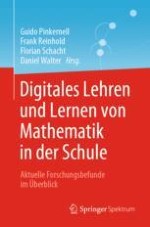2022 | OriginalPaper | Chapter
12. Daten und Zufall mit digitalen Medien
Authors : Andreas Eichler, Markus Vogel
Published in: Digitales Lehren und Lernen von Mathematik in der Schule
Publisher: Springer Berlin Heidelberg
Activate our intelligent search to find suitable subject content or patents.
Select sections of text to find matching patents with Artificial Intelligence. powered by
Select sections of text to find additional relevant content using AI-assisted search. powered by
